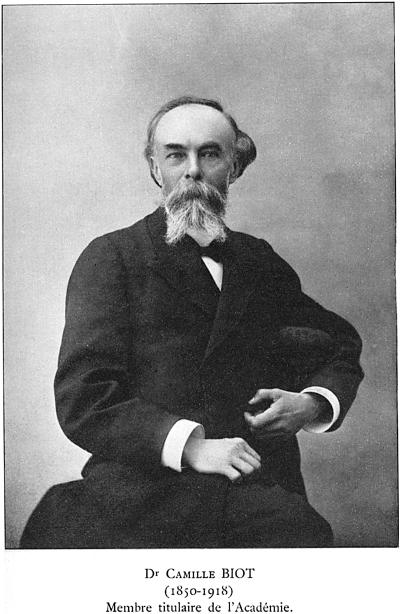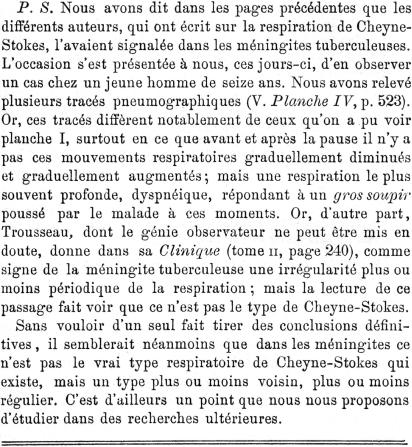Neurological disease may affect breathing cycles and rhythms.1 Several classic central periodic breathing patterns have been described. Biot's breathing—also known as ataxic breathing—is a breathing pattern in patients with acute neurological disease, but is rarely mentioned in the neurological literature. It can be contrasted with Cheyne–Stokes breathing (periodic stereotypical crescendo–decrescendo hyperpnoea followed by apnoea) and apneustic breathing (periodic prolonged inspiratory hold). Biot's breathing may be a rare phenomenon or just not noticed. Biot's contribution is discussed here.
Who was Biot?
Camille Biot was born in Chatenoy‐le‐Royal (Saône‐et‐Loire), France, on 19 December 1850. He made his seminal observations while an intern in the Hôtel Dieu Hospital in Lyon, France. After his residency, he practised medicine in Maçon in 1875. He wrote on other diverse medical topics unrelated to breathing, as well as articles about Greco–Roman–Maconne archeology. He became a member of L'Académie de Macon (Société des arts, sciences, belles lettres archeology, agriculture et encouragement au bien de Saône‐et‐Loire, fig 1). He died in Macon in 1918.2
Figure 1 Dr Camille Biot.
What was Biot's contribution?
Biot wrote two main articles on breathing patterns. One large exploratory work focused on his observations on Cheyne–Stokes breathing.3,4 In each paper, he described patients who were admitted to the Hôtel Dieu Hospital with Cheyne–Stokes respiration, his major interest. In his first article, curiously in a postscript, he described a patient who had respiratory movements that gradually decreased and increased but were irregular (fig 2), and he was one of the first to publish recordings of this type of respiration in a 16‐year‐old patient with tuberculous meningitis (fig 3). He distinguished this breathing pattern from Cheyne–Stokes breathing and named it “rhythme meningitique”. The breathing pattern is irregular and rapid, with rhythmical pauses lasting 10–30 s, but sometimes with alternating periods of apnoea and tachypnoea. This breathing pattern lacked the crescendo–decrescendo cycles attributed to Cheyne–Stokes breathing and was completely irregular with varying periods of apnoea. In 1878, a larger thesis was published entitled: Étude de Clinique et expérimentale sur la respiration de Cheyne–Stokes.4 This paper described theories of the origins of Cheyne–Stokes breathing. Biot argued that Cheyne–Stokes breathing included an increase in pulse during the pause and reduction of blood pressure during apnoea. In this now discounted theory, the accumulation of carbon dioxide would increase the activity of the vasomotor centre and vasoconstriction would cause progressive ischaemia of the respiration centre resulting in deep breaths.
Figure 2 The first description of a breathing pattern different from Cheyne–Stokes breathing. Translation: “We stated in the previous pages that the various authors who wrote about Cheyne–Stokes respiration had mentioned it in tuberculous meningitis. We have observed the case of a 16‐year‐old young man. We collected several pneumographic graphs. These graphs are conspicuously different from those that we saw in fig I, especially in that before and after the pause there is no respiratory movement that gradually decrease and increase; but, a respiration that is deep, dyspnoeic, like a big sigh from the patient during those moments. On the other hand Trousseau, whose astute observation cannot be doubted, noted in his Clinique (part II, page 240), that periodic irregularity of breathing is a sign of tuberculous meningitis; but the reading of this paragraph shows that it is not Cheyne–Stokes.Without wanting to come to a definitive conclusion, it seems that in meningitis it is not really the true type of Cheyne–Stokes respiration, but close to this type and more regular. It is an issue that should be the subject of future study.”
Figure 3 Tracing of breathing pattern described by Biot.
Was Biot the first to point out this breathing pattern?
With notable modesty, Biot added a section on earlier observations of the breathing pattern.3 Others reported this respiration as slow and as increasing to 10–20/min with accelerating periods, with unequal chest expansion: some short and incomplete, others long, deep and often interrupted by gasps.5,6,7,8 The unevenness of breathing was not related to the heart rate.5 In another report, vomiting, constipation and high fever along with short, incomplete, intermittent and gasping breathing was considered characteristic of meningitis. Similar patterns were described in Trousseau's textbook.7 Sigismond Jaccoud thought this breathing pattern was an agonal phenomenon. In his description, the pulse slows down, the breathing changes and becomes irregular, and is interrupted with deep sighs that are easy to recognise.8 Biot concluded that a big sigh comes before the pause, and that the periods are irregular. These were the two main characteristics that were always seen in meningitis and, thus, should be considered characteristic but different from the regular crescendo and decrescendo cycles of Cheyne–Stokes breathing. With much aplomb, Biot concluded that this breathing pattern should be considered separately and not as a variant of Cheyne–Stokes breathing.
What are doctors taught about Biot's breathing?
Biot's breathing is often confused with cluster breathing, regular cycles of deep breaths with variable periodicity. Many publications have inappropriately described Biot's breathing as “periodic and consisting of groups of full respiratory effort”.9 Furthermore, an experimental study on Biot's periodic breathing in cats created confusion and called it cluster breathing.10 Lesions in the pneumotaxic system of the rostral pons resulted in a breathing pattern that the authors explained as possible cyclic hypoxaemia.11
There is very little mention of Biot's breathing in clinical papers, in particular those on meningitis.12,13 It is not frequently a keyword, nor used in abstracts. There are very few PubMed citations on clinical studies accurately documenting Biot's breathing, confusing it again with cluster breathing. Plum and Posner in the their text Stupor and coma mentioned Biot in their description of ataxic breathing seen in the bulbar form of poliomyelitis.14 It is unclear whether Biot's breathing has the same characteristics. Miller Fisher, in his work on neurological examination of the comatose patient, correctly identified the main characteristics of Biot's breathing and separated it from (regular) cluster breathing.15
Is Biot's breathing folklore?
It is a hard task to find the article that introduced the eponym. In the German literature it appeared in Hofbauer's book as “Das Biotische Atmen”16 on the differential diagnosis of shortness of breath in 1904, but the author also stated that he had not observed this type of breathing, and in each case the breathing pattern was more likely Cheyne–Stokes breathing: (“Ich konnte deese Atem Form Du oft beschrieben ist, niemals finden”). In the English literature, it appeared in 1911 in the title of a review article by Connor, who observed seven patients, six of whom had meningitis.17 Biot's breathing was mentioned in text books as early as 1913 in French's index of differential diagnosis18 and in a “Companion to clinical neurology” in 2003.19 Biot's breathing may have become less obvious as a consequence of intensive care technology. Patients with this type of irregular breathing will likely be intubated as soon as they are seen, and have their breathing drive regulated by mechanical ventilation.
Acknowledgements
I thank Larry Prokop of Mayo Libraries in researching material for this manuscript. I also thank Jérôme van Wijland of the Departement of Sciences et Techniques Bibliothèque Nationale de France for providing a bibliography of Camille Biot and his portrait photo.
References
- 1.Bolton C, Chen R, Wijdicks E.et alNeurology of breathing. New York: Elsevier Science Publishers, 2003
- 2.Biot M. Discours prononces aux obseques du docteur (Camille Biot) 1850–1918. Ann Acad Macon tome XXI, 1918–19: 255–71 and plance XII
- 3.Biot M C. Contribution a l'etude du phenomene respiratoire de Cheyne‐Stokes. Lyon Med 187623517–28, 56167. [Google Scholar]
- 4.Biot M C.Etude clinique et experimentale sur la respiration de Cheyne‐Stokes. New York: Harper & Brothers, 1878
- 5.Barrier F.Pratique des maladies de l' enfance fonde sur de nombreuses observations cliniques. Paris: Charles Savy Jeune, 1845 (2 edit)
- 6.Bouchut E.Traite pratique des maladies des noureaux et des enfeants a la mamelle. et de la seconde enfance. Paris: Baillere, 1885 (2 edit 1852)
- 7.Trousseau A.Clinique Medicale de l'Hotel‐Dieu de Paris. Vol 3, 2nd edn. Paris: JB Balliere, 1865
- 8.Jaccoud S.Traite de pathologie interne. 3 volumes. Paris: Adrien Delahaye et Emile Lecrosnier, 1883, 1–911, 911–29, 911–75
- 9.Anonymous “Meningitic” breathing. JAMA 19571651568. [DOI] [PubMed] [Google Scholar]
- 10.Webber C L, Jr, Speck D F. Experimental Biot periodic breathing in cats: effects of changes in PiO2 and PiCO2. Respir Physiol 198146327–344. [DOI] [PubMed] [Google Scholar]
- 11.Hasegawa T, Kohyama J, Kohji T.et al Impairment of respiratory rhythmogenesis and sequelae of bacterial meningitis. Pediatr Neurol 199512357–360. [DOI] [PubMed] [Google Scholar]
- 12.Kuna S, Smickley J, Murchison L. Hypercarbic periodic breathing during sleep in a child with a central nervous system tumor. Am Rev Respir Dis 1990142880–883. [DOI] [PubMed] [Google Scholar]
- 13.Tai T, Adamson S. Developmental changes in respiratory febrile and cardiovascular responses to PGE (2) in newborn lambs. Am J Physiol Regul Integr Comp Physiol 2000276R1460–R1463. [DOI] [PubMed] [Google Scholar]
- 14.Plum F, Posner J.The diagnosis of stupor and coma, 3rd edn. Philadelphia, PA: FA Davis Company 198238
- 15.Fisher C M. The neurological examination of the comatose patient. Acta Neurol Scand 196945(Suppl 36)31–56. [DOI] [PubMed] [Google Scholar]
- 16.Hofbauer L.Semiologie und differential diagnosis der verschiedenen arten von kurzatmigkeit auf grund der atemkurve. Jena: Verlag von Gustav Fischer, 190425–28.
- 17.Connor L. Biot's breathing. Am J Med Sci 1911141350–360. [Google Scholar]
- 18.French H.French's index of differential diagnosis. New York: J Wright Publishers, 1913
- 19.Pryse‐Phillips W.Companion to clinical neurology. 2nd edn. Oxford: Oxford University Press, 2003





